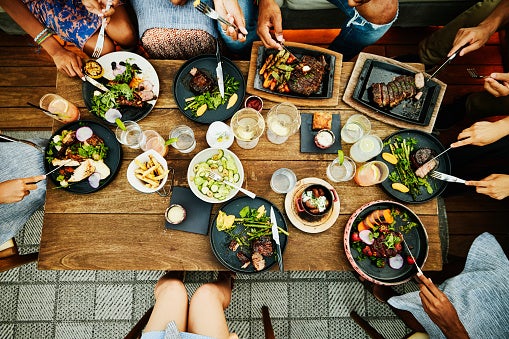Pop Quiz: name the most famous trio in the world? If you are a gourmet, your answer may have been breakfast, lunch and dinner. It is an almost universally accepted trinity – especially in the Western world.
But how did it happen?
The first meals
The first humans were nomads. Forming small communities, they were traveling with the seasons, according to local food sources.
Although we can only guess what the daily meal rhythms looked like, evidence dating from 30,000 years in the South Moravia region, the Czech Republic, show that people have visited specific colonies repeatedly. They gathered around homes, cooking and the sharing of food: the first signs of human “commensality”, the practice of eating together.
One of the best -preserved hunter sites we have found is Ohalo II – located on the banks of the Modern Sea in Galileo (also called Lake Tiberias or Lake Kinneret) in Israel, and dating from around 23,000 years.
In addition to several small dwellings with homes, it provides signs of various food sources, including more than 140 types of seeds and nuts, as well as various birds, fish and mammals.
The development of agricultural knowledge about 12,000 years ago gave rise to permanent establishments. The first were in the rising region (through modern Iraq, southwest Iran and eastern Turkey), in an area called “fertile croissant”.
Permanent agriculture has led to the production of a excess food. The ability to stay in the same place with food on hand meant that the time required to cook is no longer so important.
It quickly became common to eat a light meal at the start of the day, followed by a larger meal prepared at home later. Specific schedules would have varied between groups.
Eat together as a rule
The community nature of food and hunting research, and later agriculture meant that humans almost always ate their meals with others. In the ancient town of the city of Sparta, in the 4th century BCE, these practices were codified as the main meals called sysitia (meaning “eat together”).
These meals were consumed at the end of the day in the common dining rooms. Food was served by young boys at tables of around 15 men who lived together and fought in the same military division. Men have gradually shared generational knowledge with young boys, who themselves would join the tables at the age of 20.
In the 5th century BCE, Greek historian Herodotus sysitia has evolved from a Spartan military practice to a deep political sense in society. Likewise, Plato wrote common meals was an integral part of civil society, and that a meal was missing for no valid reason was a civic offense.
By dining at the sight of the rest of society, citizens were forced to maintain self -discipline. Meals were also an opportunity for social ties, and important discussions ranging from trade agreements to politics.
The eating habits of spartan women are missing in the texts, although it was implicit that they ate at home.
Lunches of lunches
Unlike the difficult Spartan lifestyle, the Romans appreciated their main meal, cenaEarlier in the day, followed by a lighter meal just before bedtime.
The tribes of northern Europe tend to two larger dishes per day, because more subsistence is necessary in colder climates. In Vikings, these meals were known as dagmal And nattmalor day and night meal. Nattmal was the evening meal cooked, while dagmal Generally composed in remains nattmal With the addition of bread and beer or mead.
In Australia, evidence suggests that indigenous peoples tend to a unique daily meal, which aligns the predominant kitchen method: slow cooking with hot coals or rocks in an oven on the ground. This underground oven, used by indigenous communities and also island communities of the Torres Strait, was called KUP Murri Or Kap Mauri by certain groups.
This is similar to other indigenous preparations throughout the Pacific, such as New Zealand Maori hāngīHawaiian ImamuFidjian lovoAnd even Maya píib.
The meal once a day would have been completed by snacks throughout the day.
Three is the magic number
The meal moment was strongly influenced by the structure of the classes, the local climate and the daily activities of people. Practitioner has also played a role. Without reliable lighting, meals had to be prepared and eaten before night. In colonial regions of northern Europe, this could be from 3 p.m.
So how did we go from one or two main meals to three? The answer can reside in the British royal navy.
Since its creation in the 16th century, the navy has served three regular meals to align with the routine of ships. It included a simple breakfast of ship cookies, lunch as a main meal and dinner as a light supper.

Some sources suggest that the term “square meal” can come from square wooden trays that meals have been served.
The industrial revolution, which started around 1760, undoubtedly also played a role in formalizing the concept of three specific meals in the Western world.
The pace of breakfast, lunch and dinner was routine for longer and standardized working days. The workers had breakfast and dinner at home, before and after work, while lunch was eaten with colleagues at a defined time.
With minimum breaks and no time to snack, three substantial meals have become necessary.
The fall of the Holy Trinity
Today, many factors have an impact on the time and the frequency of our meals, long work trips to juggle hobs and social obligations.
The Covid pandemic also had an impact on how and what we eat, leading us to eat larger amounts of higher calories food. The rapid growth of delivery services also means that a meal is not a few minutes from most people.
All this has led to less rigid meal times, with social meals such as brunch, euros and teas in the afternoon, we are expanding the way we connect to food. And meals will continue to evolve as our schedules will become more and more complicated.
Rob Richardson is a lecturer in culinary arts and gastronomy at the University of Auckland technology. Dianne Ma is a lecturer in culinary arts and gastronomy at the University of Auckland technology.
This article is republished from the conversation under a Creative Commons license. Read it original article.

